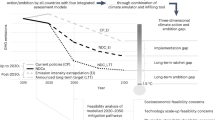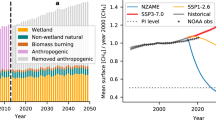Abstract
The realm of literature specifically dealing with the climate change problem has rapidly widened during the past decade. In this paper, we review scenarios aiming at emissions mitigation including stabilization of GHG emissions or concentrations in the atmosphere incorporated in integrated assessment modeling studies. To characterize the scenarios, first, the literature was scanned for model and mitigation scenario descriptions in order to lay out their common features. Second, stabilization scenarios from the IPCC SRES database were used for a quantitative analysis of their key results. We conclude with key observations of scenario characteristics and relationships between baseline scenarios and policies followed in the mitigation scenarios.
Similar content being viewed by others
References
Alcamo J, Krielman E (1996) Emission scenarios and global climate protection. Global Environmental Change—Human and Policy Dimensions 6(4):305–334
Bollen JC, Toet AMC, de Vries HJM (1996) Evaluating cost-effective strategies for meeting regional CO2 targets. Global Environmental Change—Human and Policy Dimensions 6(4):359–373
Dowlatabadi H (1995) Integrated assessment models of climate change—an incomplete overview. Energy Policy 23(4–5):289–296
Edmonds J, Kim SH, MacCracken CN, Sands RD, Wise M (1997) Return to 1990: The cost of mitigating United States carbon emissions in the post-2000 period. PNNL-11819: Pacific Northwest National Laboratories, Washington, D.C.
Edmonds J, Wise M, Sands R, Brown R, Kheshegi H (1996) Agriculture, Land Use and Commercial Biomass Energy: A Preliminary Integrated Analysis of the Potential Role of Biomass Energy for Reducing Future Greenhouse Related Emissions. PNNL-11155. Pacific Northwest National Laboratories, Washington, D.C.
Edmonds J, Wise M, Pithcer H, Wigley T, MacCracken CN (1994) An integrated assessment of climate change and the accelerated introduction of advanced energy technologies. Pacific Northwest National Laboratories, Washington, D.C.
Energy Journal, The (1999) Special issue, The costs of the Kyoto Protocol: A multi-model evaluation
EPA, U.S.E.P.A. (1990) Policy options for stabilizing global climate
Fujii Y, Yamaji K (1998) Assessment of technological options in the global energy sytem for limiting the atmospheric CO2 concentration. Environmental Economics and Policy Studies 1(2):113-139
Gaskins D, Weyant J (1993) Model comparisons of the costs of reducing CO2 emissions. American Economic Review 83(2):318–323
Ha-Duong M, Grubb MJ, Hourcade J-C (1997) Influence of socioeconomic inertia and uncertainty on optimal CO2-emission abatement. Nature 389:270–273
Intergovernmental Panel on Climate Change (IPCC) (1990) Climate change: the IPCC scientific assessment. Cambridge University Press
Intergovernmental Panel on Climate Change (IPCC) (1992) Climate change 1992: the supplemental report to the IPCC Scientific Assessment. Cambridge University Press
Intergovernmental Panel on Climate Change (IPCC) (1996) Climate change 1995: impacts, adaptations and mitigation of climate change: scientific-technical analysis. Contribution of Working Group II to the Second Assessment Report of the Intergovernmental Panel on Climate Change. Cambridge University Press
Intergovernmental Panel on Climate Change (IPCC) (1996b) Climate change 1995: economic and social dimensions of climate change. Contribution of Working Group III to the Second Assessment Report of the Intergovernmental Panel on Climate Change. Cambridge University Press
Kainuma M, Matsuoka Y, Morita T, Hibino G (1999) Development of an end-use model for analyzing policy options to reduce greenhouse gas emissions. IEEE Transactions on Systems, Man and Cybernetics Part C: Applications and Reviews, 29 (3) August 1999
Kainuma M, Matsuoka Y, Morita T (1998) Analysis of post-Kyoto scenarios: the AIM model. In: Economic modeling of climate change: OECD workshop report. Organization for Economic Cooperation and Development, Paris
Kainuma M, Matsuoka Y, Morita T, Takahashi K, Kawashima Y (1997) The international distribution of the costs of alternative global emission control proposals—some estimates by AIM. Prepared for Workshop on Climate Change Impacts and Integrated Assessment, Snowmass, Colorado, August 4-14
Kolstad CD (1998) Integrated assessment modelling of climate change. In: Nordhaus WD (ed) Economics and policy issues in climate change. Resources For Future. Washington D.C.
Manne A, Mendelsohn R, Richels R (1995) MERGE: a model for evaluating regional and global effects of GHG reduction policies. Energy Policy 23(1):17–34
Manne A, Richels R (1997) On stabilizing CO2 concentrations—cost-effective emission reduction strategies. Environmental Modeling and Assessment 2:251–265
Matsuoka Y, Kainuma M, Morita T (1995) Scenario analysis of global warming using the Asian Pacific Integrated Model (AIM). Energy Policy 23(4–5):357–371
Matsuoka Y, Morita T, Kawashima Y, Takahashi K, Shimada K (1996) An estimation of a negotiable safe emissions corridor based on AIM model. Unpublished
McKibbin WJ (1998) Greenhouse abatement policy: insights from the G-cubed multi-country model. Australian Journal of Agricultural and Resource Economics 42(1):99–113
Mori S, Takahashi M (1998) An integrated assessment model for new energy technologies and food production—an extension of the MARIA model. International Journal of Global Energy Issues 11(1–4):1–17
Morita T, Lee H-C (1998) IPCC SRES database, version 0.1, emissions scenario database prepared for IPCC Special Report on Emission Scenarios, http://www-cger.nies.go.jp/cger-e/db/ipcc.html
Moss R (1997) Comment in climate change and integrated assessment models [IAMs]—bridging the gaps. United Nations University, Tokyo, March 10–12,1997
Nakicenovic N, Grubler A et al. (1993) Long-term strategies for mitigating global warming. Energy 18(5):401–609, special issue
Nordhaus WD (1994) Managing the global commons. The economics of the Greenhouse Effect. MIT Press, Cambridge, MA
Nordhaus WD, Yang ZL (1996) A regional dynamic general-equilibrium model of alternative climate-change strategies. American Economic Review 86(4):741–765
Parson EA (1995) Integrated assessment and environmental policy-making: in pursuit of usefulness. Energy Policy 23(4–5):463–475
Peck SC, Tiesberg TJ (1995) International CO2 emissions control: an analysis using CETA. Energy Policy 23(4–5):297–208
Rose A, Stevens B (1993) The efficiency and equity of marketable permits for CO2 emissions. Resource and Energy Economics 15(1): 117–146
Rotmans J, Dowlatabadi H, Fialr JA, Parson EA (1995) Integrated assessment of climate change: evaluation of methods and strategies. In: Climate change and the social sciences: a state of the art report. Battelle Pacific Northwest Laboratories, Washington, D.C.
Tol RSJ (1997) On the optimal control of carbon dioxide emissions: an application of FUND. Environmental Modelling and Assessment 2:151–163
Tol RSJ (1999) Kyoto, efficiency and cost-effectiveness: application of FUND. The Energy Journal, Kyoto special issue:131–156
Tulpule V, Brown S, Lim J, Polidane C, Pant H, Fisher BS (1998) An economic assessment of the Kyoto Protocol using the global trade and environment model. In: Economic modelling of climate change: OECD Workshop Report, Paris
WBGU (German Advisory Council on Global Change) (1995) World in transition: The way towards global environmental solutions. Annual Report: Springer, Berlin Heidelberg
WEC (1995) Global energy perspectives to 2050 and beyond. WEC and IIASA, Austria
Weyant JP (1997) Insights from integrated assessment. In: Climate change and integrated assessment models [IAMs]—bridging the gaps. United Nations University, Tokyo, March 10–12,1997
Yohe G, Wallace R (1996) Near-term mitigation policy for global change under uncertainty: minimizing the expected cost of meeting unknown concentration thresholds. Environmental Modeling and Assessment 1:47–57
Author information
Authors and Affiliations
Corresponding author
About this article
Cite this article
Rana, A., Morita, T. Scenarios for greenhouse gas emission mitigation: a review of modeling of strategies and policies in integrated assessment models. Environ Econ Policy Stud 3, 267–289 (2000). https://doi.org/10.1007/BF03354041
Received:
Accepted:
Published:
Issue Date:
DOI: https://doi.org/10.1007/BF03354041




